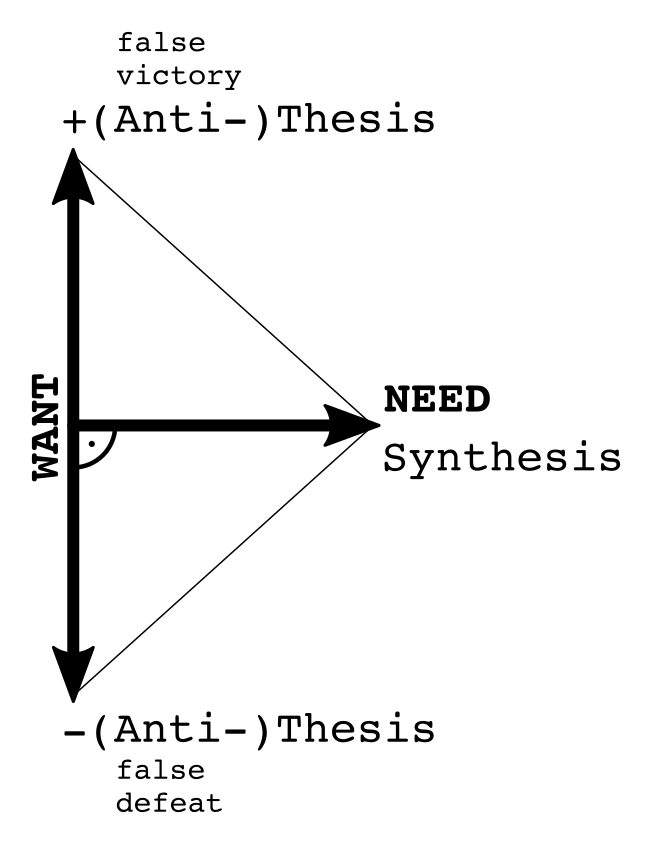This is a storytelling model that can be applied to a protagonist’s inner journey – their growth and change. I came up with it in my own work.
Let’s look at the diagram:

A character’s want and need are put into relation. The want is the more obvious goal of a character, something that person wants to achieve. This is known to the character. The need, however, is the inner longing, the one thing that would heal the character (their elixir, if you will), the thing that would make them whole. It’s usually a less tangible goal, especially since the character wouldn’t know about it for the bigger part of the story. It usually takes for the whole story to find out the need or to reach it semi-accidentally.
Both can be quantified, but in different terms. Whereas the need is simply expressed in it being reached, the want has positive and negative aspects. It can reach a positive false victory, or climb down to a negative false defeat. These extreme conditions are false, because the story doesn’t end here – cannot end here. It’s a cycle of victory and defeat, ever ongoing, unless broken by something else.
The want is the superficial story with its ups and downs that keep the story going. But in order to come to a close, it is necessary to break into the other dimension – the need. And this is why want and need are visualized perpendicular to each other. The need cannot be reached by consequently following the goal. The character has to learn something new in order to win the game.
After all, the need is the important element. If a story’s hero doesn’t fulfill their need (which means to turn one’s life for the better, to reach happiness, or content) then why the hell do you tell this story? It’s not worth anybody’s time.
But then again, if the need can be reached in a straight line, by following the goal, the story would be too simple. The audience wouldn’t be surprised. It would be obvious how the story can be solved, and it would be identical to the path the hero is following already, so he or she just has to do it. Do it already, and be done with it!
Whereas, if the story is non-obvious, the audience might know what the goal is, but doesn’t know how the hell the hero could get there, it stays to find out. And the how is the perpendicular pathway the need poses in the Want-Need Triangle.
An important thing to note is the fact that the need dimension intersects the want struggle at the neutral point. When the need is reached, the story is over. No more struggle, no more action happens on the want dimension – everything ceases to the blissful inertness the need brings. The want doesn’t matter anymore; whether it’s a true goal or a false one, there’s no difference. Even if the goal has been reached, it pales in comparison to the need.
So, a story happens when a need is unfulfilled, and it deals with the struggle that unfolds thusly. The thesis (aka the first act) is formulated, and then contested in the anti-thesis (the second act) while the want dimension oscillates between its poles. But it takes both the happy moments and the despair to unlock the path to character change and eventually to the fulfillment of the need. Here, the theses come together to form the synthesis (the third act) and the story stops oscillating and comes to a halt.
This model might fit especially well for a story in which the obvious want is false. E.g. a story in which the hero wants to have riches, but in fact needs something very different. The story can still go two ways, having the hero actually end up with lots in their pocket, but finding out that money isn’t everything. Or the hero ending up poor as you can be, but finding out that money isn’t everything. In any case, the mysterious need must be so grand that the financial situation doesn’t matter in the end.
But even if the want is not false, this model can be used to make the character more interesting, to add depth to their characterization. Make the need perpendicular to the want/the goal. Figure it out.
Notes: “False victory” and “false defeat” apply here as used in Blake Snyder’s Save the cat!. “Elixir” refers to “Return with the Elixir” as used in Christopher Vogler’s The Writer’s Journey.